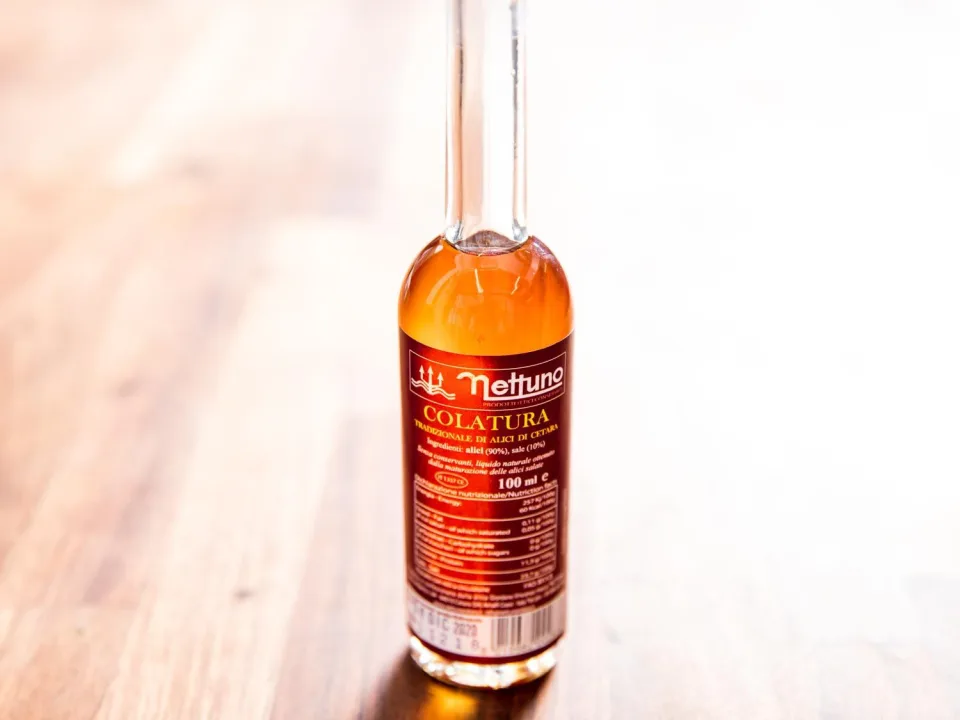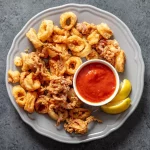You may have noticed we’ve been on a bit a seafood umami pantry ingredients kick lately, starting with Sho’s deep dive into “the Parmesan the sea,” bottarga. Then, I paid tribute to XO Sauce, one of the best condiments ever.
Advertisement Banner
Colatura di alici is another Italian fish delicacy that you should try at least once in your life. Colatura is a pantry item with umami that you must try at least one time in your life. You will not want to be without it once you try it.
What is Colatura di Alici?
Colatura is the Italian version of Southeast Asian fish paste, and it’s a close relative of garum, the ancient Roman sauce (and the current darling in the world of chefs who can ferment anything, thanks to Noma’s fermentation lab).
Colatura, a traditional, high-quality fish sauce of Southeast Asian style, is made from just two ingredients, anchovies, and salt. These products are also produced in much the same way, by layering anchovy fillets and salt in wooden barrels, and then setting them aside in a temperature-controlled environment to ferment for a long, long time.
The anchovies will exude a liquid which will eventually age into colatura. Colatura di alici is an Italian term that means “anchovy drips.” This is the most straightforward product description you could hope for.
How is Colatura made?
Recently, I picked up a bottle colatura at the Bronx warehouse headquarters for Gustiamo. This online seller of Italian specialty products is based in Bronx. Beatrice Ughi, the owner and founder of Gustiamo, spent some time with me talking about ingredients. We also talked about our favorite Roman cafes and New York pizzerias.
Beatrice took me through the process of making the colatura they sell, which is made by a company called Nettuno (Neptune). Nettuno’s colatura is made by gutting and filleting local anchovies, and then layering them with Sicilian salt, all done by hand, in small barrels of chestnut called terzigni. This term refers to the barrels’ diminutive size.
The barrels will then be aged by weighting down the terzigno lids. The anchovies, as mentioned above, are allowed to ferment, release liquid and age up to three year. Comparatively, the best Southeast Asian fish pastes are usually aged for one year. (There are some specialty fish sauces, like Red Boat’s Chef’s Cuvee, that are double-aged in Bourbon barrels).
Then, when Nettuno’s tasters decide that the colatura has reached the top of the weights, they tap the hole at the bottom of the terzigno. The colatura then drains down the barrel and passes through the anchovies. This gives the fish sauce a final boost in flavor, while also filtering it. The colatura will then be bottled for sale.
Nettuno Anchovy Colatura
Buy on Gustiamo.com
Why You Should Purchase a Colatura Bottle
Colatura, like other aged products, such as Parmesan, dried scallion, Scotch Whiskey, or dry-aged Beef, is not cheap. The process of aging reduces the yield, increases inventory and takes up valuable space. It is cheaper to make a large quantity of Jack cheese that only needs to be aged for a few months than to age a clothbound cheese for more than a year. This cost must be passed on to the consumer. You get a huge flavor payload in return. It’s difficult to describe the intensely delicious taste of colatura. It is salty, tastes like the sea but doesn’t taste fishy.
I like Southeast Asian fish sauce and I don’t think colatura should replace it. They taste totally different even though they are made with the same ingredients. The same ingredients can produce wildly different results, just like whiskey. Although I haven’t had fresh Vietnamese anchovies yet, I’d bet they won’t taste the same as those from the Amalfi coast. Salt is also different. There are also differences in the wood barrels and the ambient air. Sho was sceptical about the reverence given to colatura. However, when we tried it with a premium Vietnamese Fish Sauce, he reluctantly admitted that both were delicious, but had vastly different flavors.
If you enjoy the umami flavor of fish sauces from supermarkets in Southeast Asia, then you’ll love colatura. Just use it more carefully. It’s the equivalent of aged balsamic, but it is a speciality finishing product. You wouldn’t just throw it into your steak marinade at random. A little colatura can go a long way.
Colatura
Colatura has many uses. Use it to flavor grilled vegetables, steaks, fish, and pork roasts. You can use it to spice up bagna cauda or Caesar salad dressing. You can also make spaghetti with la colatura di Alici, one of the easiest pasta dishes to prepare on a weeknight.


